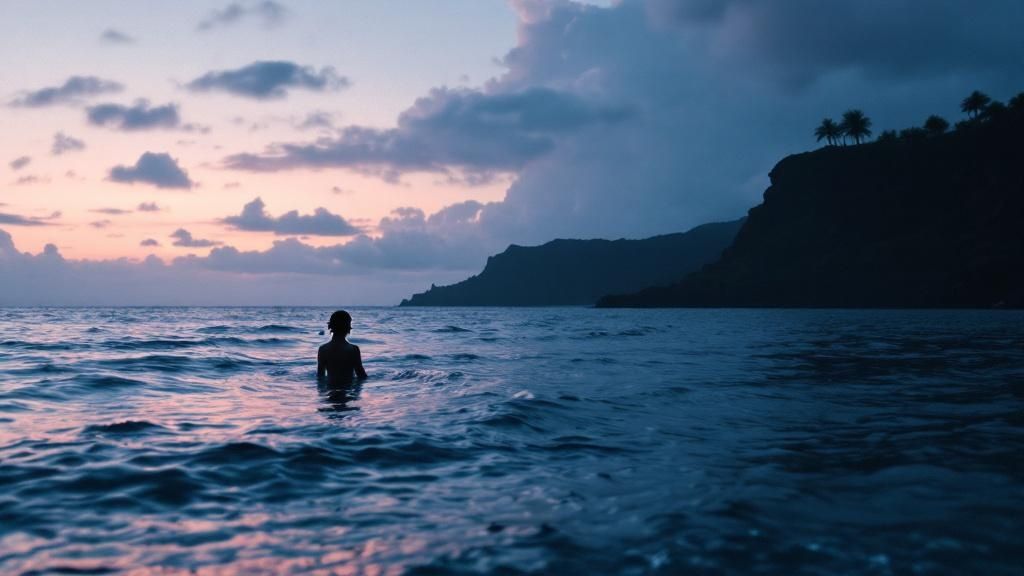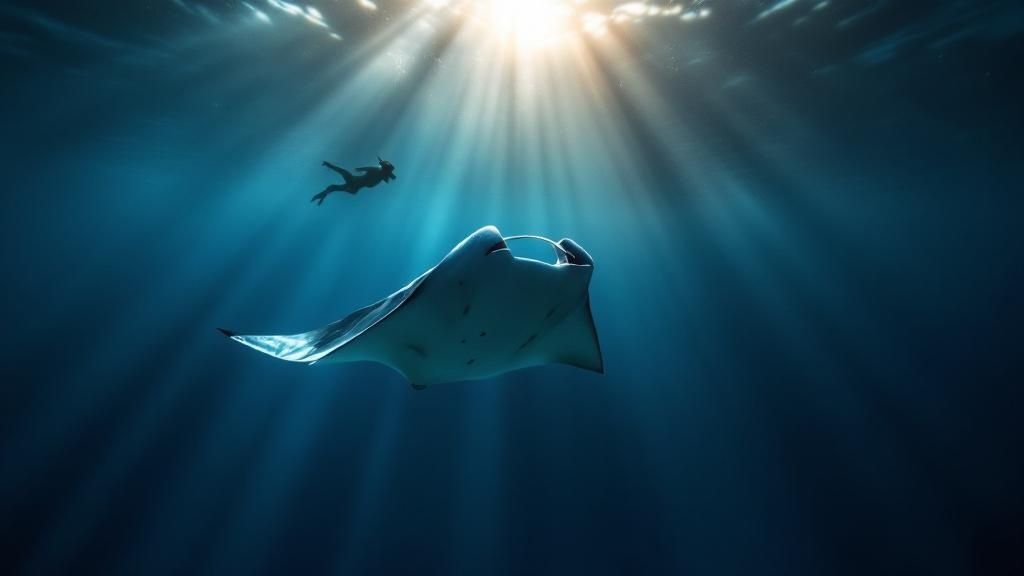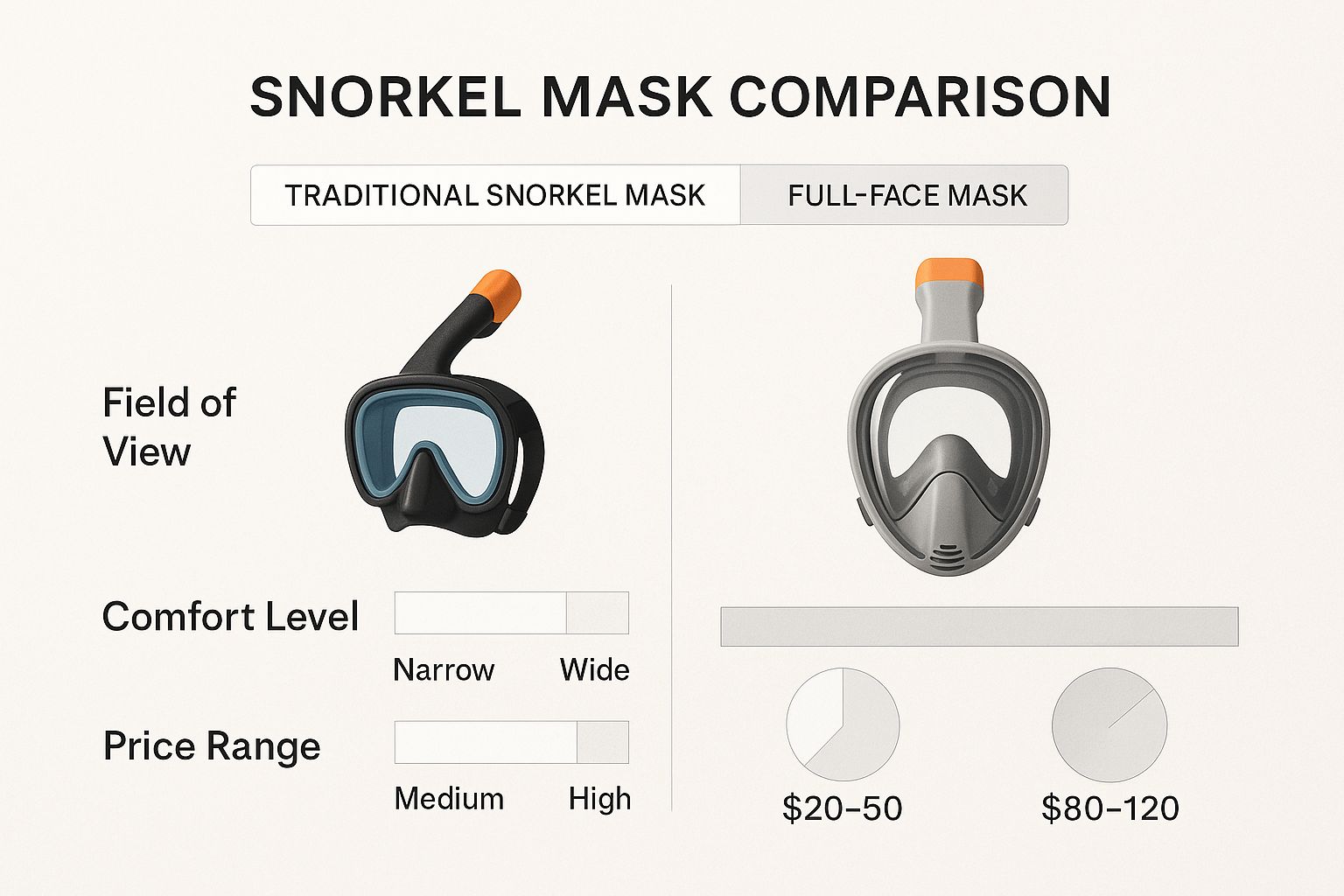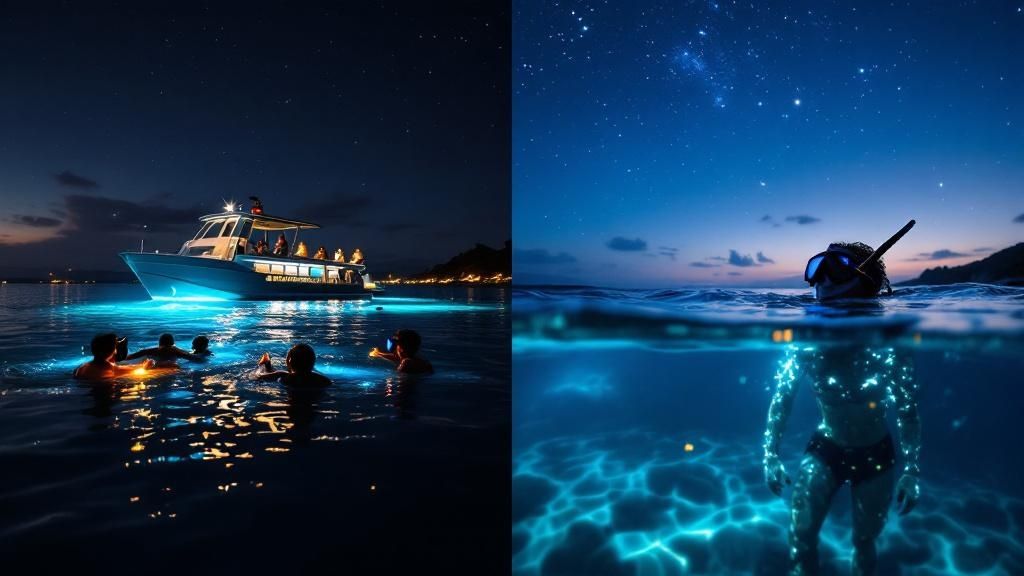Manta Ray Snorkel Big Island: Ultimate Guide & Top Tours
- Byron
- Jul 29
- 11 min read
Picture this: you’re floating in the calm, dark Pacific Ocean. Just inches below, majestic manta rays with wingspans up to 16 feet glide and somersault with effortless grace. It’s no wonder the manta ray snorkel on the Big Island is consistently called one of the planet's most unforgettable wildlife encounters. Kona isn't just a good spot for this—it's the world's most reliable place to experience this magic.
Your Guide to an Unforgettable Night Snorkel
Jumping into the ocean after dark might sound a little intimidating, but this whole adventure is designed to be incredibly safe, inspiring, and accessible for almost everyone. Think of it as an underwater ballet where you have the best seat in the house.
Here’s how it works: you float comfortably on the surface while powerful lights shine down into the water. These lights act like a magnet for tiny plankton, creating a floating buffet. This, in turn, is the dinner bell for the local manta rays, drawing them in for a spectacular feeding show right before your eyes.
But you don't have to take our word for it. See what fellow snorkelers have to say about their own experiences with Manta Ray Night Snorkel Hawaii.
Why Kona is a Global Manta Hotspot
The Big Island isn't just one of many places to see manta rays; it is the premier destination in the world. Why? Because the Kona coast is home to a thriving, non-migratory population of over 450 identified reef mantas.
These aren't just passing visitors—they live here year-round. This incredible consistency gives tours an 85-90% sighting success rate, with an average of about three mantas showing up each trip. Your chances of having a jaw-dropping encounter on any given night are incredibly high.
The feeling of a 12-foot gentle giant somersaulting directly below you is indescribable. It’s a mix of pure awe and a deep connection to the natural world, all happening in a silent, beautiful underwater theater.
To give you a quick snapshot, here’s what makes this snorkel tour such a standout experience.
Big Island Manta Ray Snorkel At a Glance
Aspect | What to Expect | Why It's So Special |
|---|---|---|
The Setup | Floating on the surface holding a custom light board. | A passive, respectful way to observe wildlife without disturbing it. |
The Stars | Gentle reef manta rays, some with 12-foot+ wingspans. | You're witnessing natural feeding behavior, not a trained animal show. |
The Location | The calm, clear waters off the Kona Coast. | Home to a massive, year-round manta population, ensuring high success. |
The Vibe | Peaceful, awe-inspiring, and almost spiritual. | It’s a silent, beautiful ballet happening just inches away from you. |
This isn't just another snorkeling trip; it's a profound connection with nature that you’ll remember for a lifetime.
What Makes This a Must-Do Experience
This isn't about just spotting a big fish from a distance. It's about a peaceful, passive interaction that puts the animals' well-being first. The whole experience is built on a simple yet brilliant idea:
Lights attract plankton, which is the mantas' favorite food.
Mantas come to feed on the dense cloud of plankton.
You get to watch from the surface, holding onto a specially designed light board.
This genius setup allows for breathtakingly close views without ever disturbing the mantas. It's a perfect blend of adventure, education, and pure wonder.
For a deeper dive into what makes this activity so special, check out our complete guide to Hawaii's magical manta ray night snorkel.
Ready to take the first step toward this incredible journey?
Meet the Gentle Giants of the Kona Coast
Jumping into the ocean to see its creatures is one thing, but getting an invitation to their dinner table? That’s a whole different level of incredible. The manta ray snorkel on the Big Island isn't just another tour; it's a front-row seat to the natural behaviors of some of the smartest animals in the sea. The reef manta rays you’ll meet aren't trained performers—they’re wild animals, and you're witnessing their nightly ritual.

The whole experience is built on a simple yet brilliant idea. Tour operators use powerful, underwater lights that draw in huge swarms of plankton, which happens to be the manta rays' favorite food. This creates a reliable, concentrated "dinner buffet" right in the water. The mantas, knowing a good meal when they see one, gracefully glide in to feast, performing what looks like a mesmerizing underwater ballet as they filter-feed.
This dependable food source is a huge part of what makes Kona such a special place for manta encounters. If you want to dive deeper into trip planning, check out our full guide on the best time to see manta rays in Kona.
A Unique and Local Population
The manta rays you'll see in Kona are true island locals. Unlike many marine animals that travel vast ocean distances, the reef mantas here tend to stick close to home. This has created a population that is not only familiar to local guides and researchers but also genetically distinct from other groups.
It turns out these animals are even more special than we thought. A recent study found that the reef manta rays around Hawai'i Island live in small, genetically isolated communities, with only a few hundred individuals in each one. These mantas don't really mix between islands, which means the Kona population is a unique and fragile community all its own.
This makes every single manta ray here incredibly important for the health of the local ecosystem.
Understanding that you're watching a distinct, island-specific family of mantas completely changes the experience. It highlights our responsibility to be respectful, quiet observers, ensuring these gentle giants can thrive in their natural home for generations to come.
While the Kona Coast offers this truly exceptional manta ray snorkel on the Big Island, the ocean is full of other amazing sights and renowned dive and snorkel sites like Balicasag Island. Every unique spot shows off the incredible diversity of our planet's oceans.
Your adventure in Kona is more than just a swim. It’s a rare chance to see a very specific, localized natural wonder unfold right before your eyes.
How to Choose the Best Time for Your Snorkel
One of the first questions people ask is, "When is the best time for a manta ray snorkel on the Big Island?" The fantastic answer is that these gentle giants live here year-round, so any night is a great night for an unforgettable show. Unlike migrating animals, Kona's resident mantas stick around, giving tours an incredibly high success rate no matter the season.

That said, if you really want to dial in your experience, there are a few small things to think about. While the month you visit doesn't matter much, things like moon phases and nightly ocean conditions can play a small role. For instance, a darker night during a new moon can make the tour lights even more of a magnet for plankton—the mantas' favorite food.
How Tour Operators Ensure Success
The real key to consistent sightings isn't luck; it's expertise. Reputable tour operators don’t just anchor the boat and cross their fingers. They rely on years of experience and up-to-the-minute information to pick the best possible spot for your snorkel. This is where historical data becomes so important.
For years, dedicated underwater videographers have been monitoring manta rays off the Kona Coast. They've created detailed records of individual mantas, their habits, and their favorite hangouts. This incredible tracking effort has been essential for confirming the area's reputation and building sustainable tourism around these animals. You can explore more about these fascinating insights on manta ray statistics and their importance.
This is exactly why your captain might choose "Manta Village" one night and "Manta Heaven" the next. They aren't guessing—they're using real-time information and historical patterns to put you in the perfect position for a spectacular encounter.
The most important decision isn't which month to visit, but choosing an experienced crew that understands manta behavior. Their knowledge is your best guarantee for an amazing trip.
So, while any time is a good time for your manta ray snorkel on the Big Island, booking with a knowledgeable operator like Manta Ray Night Snorkel Hawaii is the secret ingredient. You can book with confidence, knowing that experts are working behind the scenes to make your experience magical.
Ready to find your perfect date with the mantas?
What to Expect on Your Manta Ray Night Tour
Knowing what your adventure holds can turn any pre-trip jitters into pure, buzzing excitement. So, let’s walk through the whole experience, from the moment you check in to the grand finale: floating in the dark ocean as these gentle giants perform an underwater ballet right below you. This is what a premier manta ray snorkel on the Big Island really feels like.
Your tour kicks off with a warm welcome at check-in. The crew is there to make you feel comfortable right away, setting a friendly and professional tone for the evening. From there, you'll get a full safety briefing.
They’ll cover everything you need to know about your gear, what to expect once you’re in the water, and most importantly, how to interact with the mantas respectfully. The goal is to make sure everyone feels confident and ready for the adventure ahead.
Next, you'll hop on the boat for a short, scenic ride out to one of Kona's world-famous manta viewing sites. Depending on when your tour is, this could be a stunning sunset cruise along the coast or a peaceful trip under a sky blanketed with stars.
The In-Water Experience
This is the moment everyone waits for. Once the boat anchors, the crew helps you slip into the water and guides you to a big, floating light board. You’ll hang onto this raft, which has powerful lights that shine straight down into the depths.
This is the secret sauce. The bright lights attract a huge cloud of plankton—the manta rays’ favorite meal.
Imagine this: you're floating weightlessly on the surface, just peering down into the glowing water below. All of a sudden, a massive, graceful shadow emerges from the darkness. It swoops and somersaults with its mouth wide open, feeding on the plankton. They glide just inches beneath you.
The whole thing is incredibly peaceful. It’s a silent dance between light, life, and the vast ocean. You're simply an observer, invited to their dinner table, and the feeling is something you'll never forget. Many people find it to be a life-changing encounter that builds a deep, personal connection to the sea.
To see what kind of tours are available, check out our guide on the top manta ray snorkel Big Island tours for 2025.

Comparing Kona's Premier Manta Snorkel Sites
There are two primary locations where the tours go, and your captain will pick the best spot for the night based on where the mantas have been most active. This strategy gives you the highest chance of having an amazing encounter.
Here’s a quick look at the two main sites.
Comparing Kona's Premier Manta Snorkel Sites
Feature | Manta Village (Keauhou Bay) | Manta Heaven (Near Airport) |
|---|---|---|
Location | South of Kailua-Kona, near the Sheraton | North of Kailua-Kona, near the airport |
Travel Time | Shorter boat ride (often under 15 mins) | Longer boat ride (around 30-45 mins) |
Consistency | Historically the most consistent site for sightings | Excellent consistency, known for large groups of mantas |
Conditions | Generally very calm, protected in a bay | Can be more exposed to open ocean conditions |
Ultimately, both locations offer incredible opportunities for your manta ray snorkel on the Big Island. You can trust the crew's expertise to get you to the right place for a successful and unforgettable adventure.
Safety Tips and Gearing Up for Your Adventure
When you're out on the water, your safety and the well-being of the manta rays are always priority number one. Any reputable manta ray snorkel Big Island tour, like us at Manta Ray Night Snorkel Hawaii, will provide all the essential gear you need to feel comfortable and secure from the moment you step on the boat.

You can expect to be fitted with a wetsuit to stay warm, a quality mask and snorkel for crystal-clear views, and any necessary flotation aids. The real star of the show, equipment-wise, is the custom light board. You’ll hold onto this board as you float, and its light is what draws in the plankton that the mantas come to feed on.
What to Bring and What to Expect
While we’ve got the main gear covered, bringing a few personal items will make your trip much more comfortable. Don’t forget to pack a towel and a dry change of clothes for after the snorkel—the boat ride back can feel a bit brisk once you’re out of the water!
Most importantly, come ready to be a good guest in the mantas' home. Your guide will walk you through the "rules of the ocean" before you get in. It's best to think of yourself as a passive observer, lucky enough to get a front-row seat to their nightly dinner show.
The Golden Rule of Manta Encounters
There's one rule that stands above all others, and it's simple: do not touch the manta rays. These gentle giants are covered in a protective mucous coating, which is their primary defense against harmful bacteria in the ocean. Touching them, even accidentally, can rub off this vital layer and leave them vulnerable to dangerous infections.
It all comes down to respect and responsibility. By keeping your hands to yourself and simply floating, you help the mantas feel safe. This allows them to carry on with their incredible, acrobatic feeding ballet right in front of you.
Your guide will also instruct you to stay on the surface and never chase or dive down after the mantas. Following these guidelines is what makes a successful and ethical encounter possible. To help ensure these amazing creatures are around for generations to come, it's always great to learn more about key tips for ocean conservation. For a deeper dive, our manta ray snorkel Big Island guide offers expert encounter tips.
By following these simple rules, you're guaranteed the most authentic and breathtakingly close experience possible. Now is the perfect time to secure your spot for this unforgettable adventure.
Common Questions About Manta Ray Snorkeling
Even with all the excitement bubbling up, it’s completely natural to have a few last-minute questions before you book your manta ray snorkel on the Big Island. We get it! To help put your mind at ease, we've gathered the most common questions we hear from our guests.
What If No Manta Rays Show Up?
This is probably the number one concern we hear, but we have great news: it's incredibly rare! The Kona Coast is home to one of the most reliable and consistent manta ray populations on the entire planet. Sighting success rates are consistently above 90%.
That said, we're dealing with wild animals in their natural habitat, so a sighting can never be 100% guaranteed. Reputable tour operators understand this. In the very unlikely event that the mantas decide not to come out and play, most companies—including Manta Ray Night Snorkel Hawaii—will let you rebook your tour for free on another night. It’s always a smart move to schedule your snorkel early in your trip, just in case you need that flexibility.
Is There a Best "Season" to See Mantas?
Nope! This is one of the best parts about this adventure. The manta rays you'll meet are residents of Kona, not migratory tourists passing through. They live and feed in these waters all year long, so any time of year is a fantastic time to see them. Their nightly appearance is all about the food source (plankton), not the month on the calendar.
The most crucial factor isn't the calendar date but the expertise of your tour operator. Experienced crews know the mantas' habits and use daily insights to choose the best viewing location each night, maximizing your chances of a spectacular show.
What’s the Difference Between Snorkeling and Diving?
The main difference is your vantage point in the water, and both are incredible.
Snorkelers: You get to float right on the surface, holding onto a custom-built light raft. The lights shine down into the deep, drawing the plankton in. This gives you a spectacular bird's-eye view as the mantas swoop, barrel-roll, and feed just inches below you.
Divers: Certified scuba divers head down to the ocean floor (about 35 feet) and look up. They get to see the show from below, watching the mantas perform an underwater ballet silhouetted against the bright lights at the surface.
Both options offer mesmerizingly close encounters. Snorkeling is much more accessible for families, beginners, and anyone without a dive certification, and it's an equally thrilling way to experience the magic. Our complete journey guide has even more detail on what to expect.
Is It Safe to Swim with Manta Rays?
Absolutely. There's a reason they're called "gentle giants." While they share a family tree with stingrays, manta rays do not have stingers, barbs, or teeth. They are harmless filter-feeders, and their diet is made up entirely of microscopic plankton. They pose no threat to people and are simply curious about the lights and the commotion.
Can I Touch a Manta Ray?
Please, don't. While it might be tempting as they glide so close, touching a manta ray is very harmful to them. Their skin is covered in a delicate, protective mucus layer that works like their immune system, shielding them from bad bacteria in the ocean. When a person touches them, it can rub off this vital coating and leave them vulnerable to skin infections.
By simply observing and not touching, you help keep these beautiful animals healthy and ensure the manta ray snorkel Big Island experience can be enjoyed for generations to come.
Ready to book your spot for this unforgettable adventure?
Comments